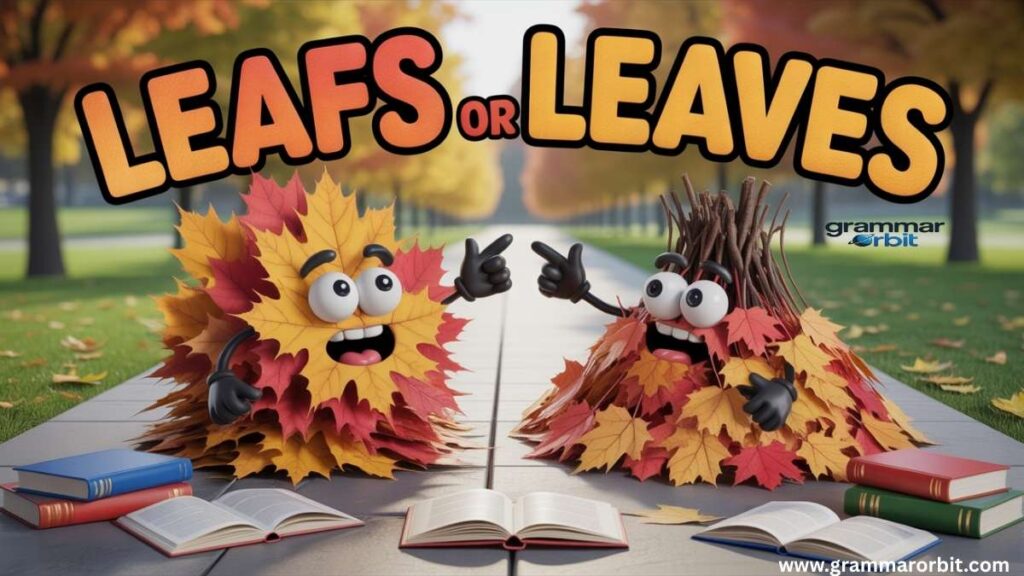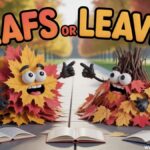Ever stared at the word leafs and thought, “That can’t be right… or can it?” You’re not alone. The eternal debate of leafs or leaves has caused more confusion than a squirrel in a leaf blower. One sounds proper, the other sounds like your spell checker gave up. Yet somehow, both exist and one even made it onto hockey jerseys! English grammar loves to keep us guessing, and this tiny word proves it. So grab your favorite drink, settle in, and let’s finally uncover why nature uses leaves, hockey fans cheer for Leafs, and grammar teachers sigh in between.
The Quick Answer: Leaves Is the Correct Plural of Leaf
The correct plural form of leaf is leaves.
When you describe more than one leaf from a plant or tree, you say:
The tree dropped its leaves in autumn.
You do not say leafs in this case. The reason comes from one of English’s oldest grammar patterns: when a word ends in f or fe, its plural often changes to ves.
Here are some common examples:
- Knife → Knives
- Wolf → Wolves
- Shelf → Shelves
- Leaf → Leaves
These are part of a special group called irregular plural nouns. The “f” sound changes to a “v” sound when forming the plural. English adopted this pattern hundreds of years ago, and it has stayed ever since.
Why Leaf Becomes Leaves
Understanding this rule helps you recognize similar patterns in English.
Words ending in f or fe often follow the same sound change. When you add an “s,” the sound between the two letters becomes softer. So, leaf becomes leaves, knife becomes knives, and life becomes lives.
Not every word with an “f” follows this rule, though. For example, roof becomes roofs, not rooves. English borrowed words from many languages, so spelling and sound patterns sometimes mix.
Common f → ves Patterns
| Singular | Plural | Pattern | Notes |
|---|---|---|---|
| Leaf | Leaves | f → ves | Standard irregular plural |
| Wolf | Wolves | f → ves | Common example |
| Half | Halves | f → ves | Keeps same rule |
| Shelf | Shelves | f → ves | Similar sound |
| Knife | Knives | fe → ves | Classic example |
| Life | Lives | fe → ves | Same pattern |
| Roof | Roofs | Regular | Exception to rule |
If you remember that many f words change to ves, but some do not, you will know why English learners often double check this rule.
When Leafs Is Actually Correct
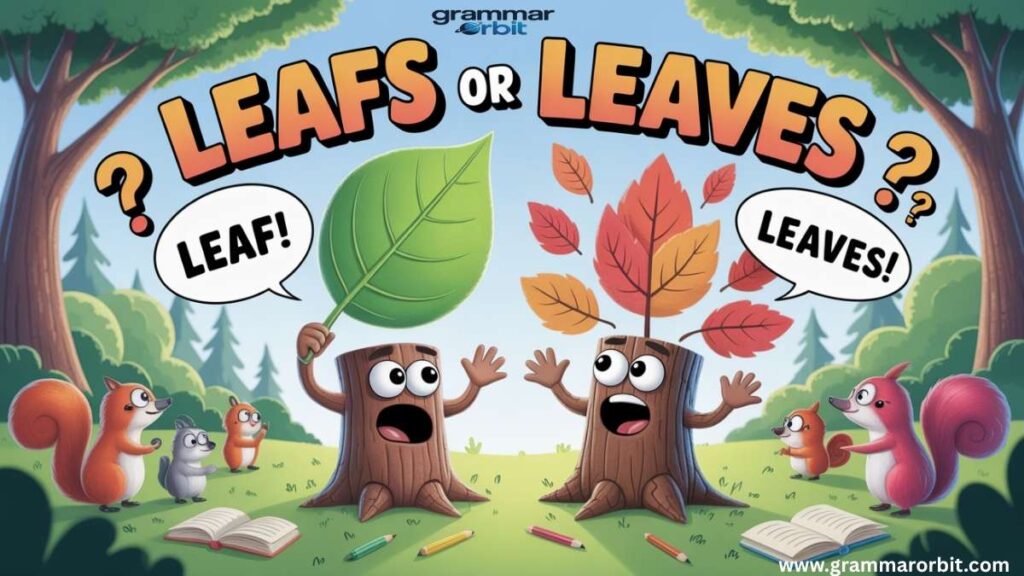
Now let’s clear up the biggest confusion. Leafs is not always wrong. It is correct in a few specific situations.
The Toronto Maple Leafs
The most famous exception is the Toronto Maple Leafs, Canada’s professional ice hockey team.
The team got its name in 1927 when Conn Smythe, the owner, wanted to honor the Maple Leaf Regiment from World War I. When people asked why he chose “Leafs” instead of “Leaves,” Smythe replied that team names are proper nouns and do not need to follow grammar rules.
He said, “You don’t change a name just because grammar says so.”
That decision turned “Leafs” into a symbol of pride, tradition, and national identity. The name has stayed the same for almost a century. The team’s brand and history matter more than grammar in this case.
Other Proper Noun Exceptions
Many company and product names ignore grammar rules for style or identity.
Examples include:
- Toys “R” Us
- Chick fil A
- Dunkin’
So while leafs breaks the normal grammar rule, it remains correct when used as a proper noun. When you refer to the hockey team, you must write Toronto Maple Leafs, not Toronto Maple Leaves.
Context Changes Everything: Noun vs Verb
The word leaf can serve as both a noun and a verb. The correct form depends on its role in the sentence.
As a noun, it refers to the green part of a plant.
As a verb, it means “to turn pages quickly,” as in reading or flipping through a book.
Examples in Sentences
| Type | Sentence | Correct Form | Explanation |
|---|---|---|---|
| Noun | The wind blew the leaves off the tree. | Leaves | Plural of the noun leaf |
| Verb | She leafs through the magazine every morning. | Leafs | Present tense verb |
| Proper Noun | The Toronto Maple Leafs won their game. | Leafs | Team name |
When you use leaf as a verb, the third-person singular form adds an “s.” So, he leafs, she leafs, it leafs just like he runs or she reads.
This use is less common, but it appears often in literature, newspapers, and daily conversation when someone quickly flips through pages.
Meaning of Leafs and Leaves
The two words carry different meanings depending on context.
Leafs meaning:
- To flip through pages (verb form).
- The name of the Toronto Maple Leafs hockey team (proper noun).
Leaves meaning:
- The plural of leaf (noun).
- The form of the verb “to leave,” meaning to go away (example: “He leaves the house at 8 a.m.”).
Understanding part of speech and context helps you choose the right word instantly.
What Does “Can I Get A Hoya” Really Mean?
How to Use Leafs and Leaves Correctly

Use leaves when you mean more than one leaf or describe anything related to nature.
Use leafs when you describe someone turning pages or mention the Toronto Maple Leafs.
Quick Reference Table
| Use Case | Word | Example |
|---|---|---|
| Trees or plants | Leaves | The tree shed its leaves. |
| Turning pages | Leafs | He leafs through the report. |
| Toronto hockey team | Leafs | The Toronto Maple Leafs played last night. |
Easy rule:
If your sentence involves trees, say leaves. If it involves books or hockey, say leafs.
Pronunciation Guide Leafs or Leaves
The difference between leafs and leaves shows in their sound as well as spelling.
| Word | Pronunciation | Phonetic Spelling | Rhymes With |
|---|---|---|---|
| Leafs | /leefs/ | leefs | Chiefs |
| Leaves | /leevz/ | leevz | Thieves |
Simple trick:
“Leaves” sounds softer because the “f” changes to a “v.”
“Leafs” keeps a sharp “f” sound, which matches its spelling.
Hearing and saying the difference helps you sound more natural in speech.
Common Mistakes and How to Fix Them
Even fluent speakers sometimes confuse these forms.
Mistake 1: Using leafs instead of leaves for trees
Wrong: The tree dropped its leafs.
Correct: The tree dropped its leaves.
Mistake 2: Using leaves instead of leafs for the verb
Wrong: He leaves through the pages.
Correct: He leafs through the pages.
Mistake 3: Assuming leafs is never a real word
Wrong: Leafs is not a valid word.
Correct: Leafs is valid as a verb and as a team name.
Grammar Tip: Identify whether you are talking about a thing, an action, or a name. Once you know the part of speech, you will always choose the right form.
Examples Leafs or Leaves
In Academic Writing
Scientists might write:
“The leaves contain chlorophyll, which produces food for the plant.”
This example uses leaves correctly as a plural noun.
In Daily Conversation
“She leafs through the newspaper before breakfast.”
Here, leafs acts as a verb and fits perfectly.
In Sports Reports
“The Toronto Maple Leafs secured another victory.”
This shows how Leafs becomes correct as a proper noun.
Real world examples help make grammar memorable because they connect words to context.
What Does “Watch Your Six” Mean?
Symbolism and Cultural Significance of Leaves
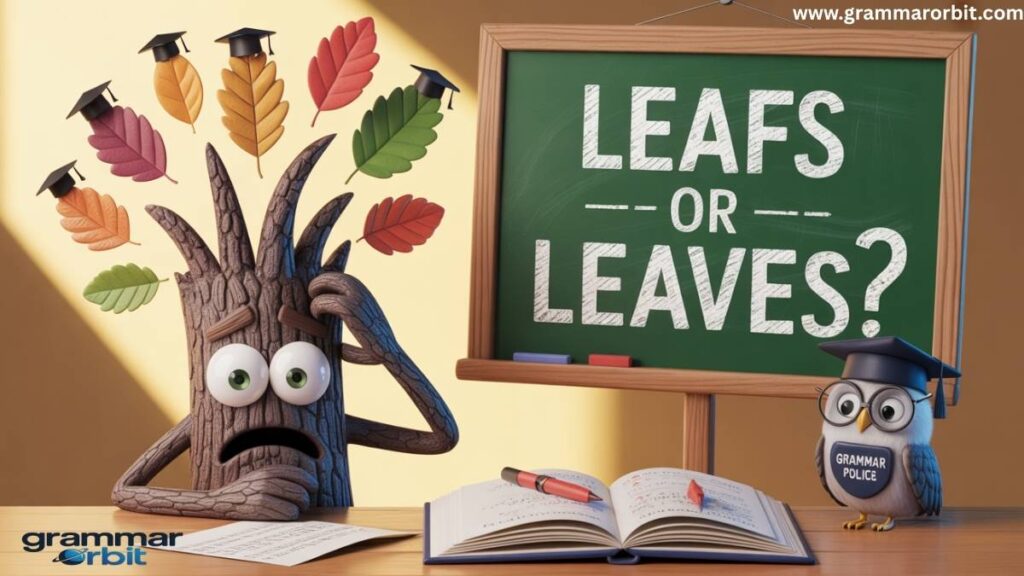
The word leaves appears in literature, art, and philosophy with deep meaning.
Leaves symbolize:
- Growth
- Change
- Renewal
- Life cycles
Authors use them to show time passing, personal growth, or transformation.
Emily Brontë once wrote:
“Every leaf speaks bliss to me, fluttering from the autumn tree.”
The falling leaf represents the natural rhythm of life and change.
Common Idioms Using Leaves
- Turn over a new leaf Begin again or change behavior.
- Take a leaf out of someone’s book Follow another person’s example.
- Green as a leaf Inexperienced or new to something.
These expressions show how the plural form leaves connects with everyday speech and deep cultural ideas.
How to Teach the Difference

Teachers and language learners often struggle with irregular plurals. A few simple methods make the rule easier to remember.
Steps for Teaching Leafs vs Leaves
- Show Visuals: Display one leaf and then many leaves to make the concept concrete.
- Demonstrate Sound: Say “leaf” and “leaves” out loud so learners can hear the change from “f” to “v.”
- Use Context Sentences:
- He leafs through the pages.
- The leaves are green.
- Discuss the Exception: Explain the Toronto Maple Leafs as a fun and memorable rule breaker.
- Interactive Activity: Create a word sorting game. Ask students to decide which “f” words become “ves” and which do not.
- Repeat Frequently: Reinforce pronunciation and spelling through regular practice.
Teaching Tip: Connect grammar to meaning. When students understand why the rule exists, they remember it longer.
Mnemonic to Remember
An easy way to recall the difference:
Nature leaves, hockey leafs.
This quick phrase sticks in your memory and instantly tells you which word to use.
English Pluralization Rules
To make this clearer, here is a quick reference for common plural patterns:
| Rule Type | Example | Plural Form | Explanation |
|---|---|---|---|
| Add -s | car → cars | cars | Regular rule |
| Add -es | box → boxes | boxes | For words ending in x, s, ch, or sh |
| Change -y to -ies | baby → babies | babies | For words ending in consonant + y |
| Change -f or -fe to -ves | leaf → leaves | leaves | Sound change rule |
| Irregular form | man → men | men | Completely different plural |
| No change | sheep → sheep | sheep | Same singular and plural |
Knowing these patterns makes English plural forms easier to predict and remember.
Leafs or Leaves in Modern English
Modern English speakers still use both words, depending on context. Dictionaries like Merriam-Webster and Oxford recognize leaves as the correct plural of leaf, but leafs remains valid as a verb and as part of proper names.
Writers and artists sometimes use leafs creatively to show dialect, humor, or brand identity. While leaves fits formal and academic writing, leafs shows flexibility and creativity in modern language.
Forrest Or Forest What’s The Difference?
Why Grammar Exceptions Matter
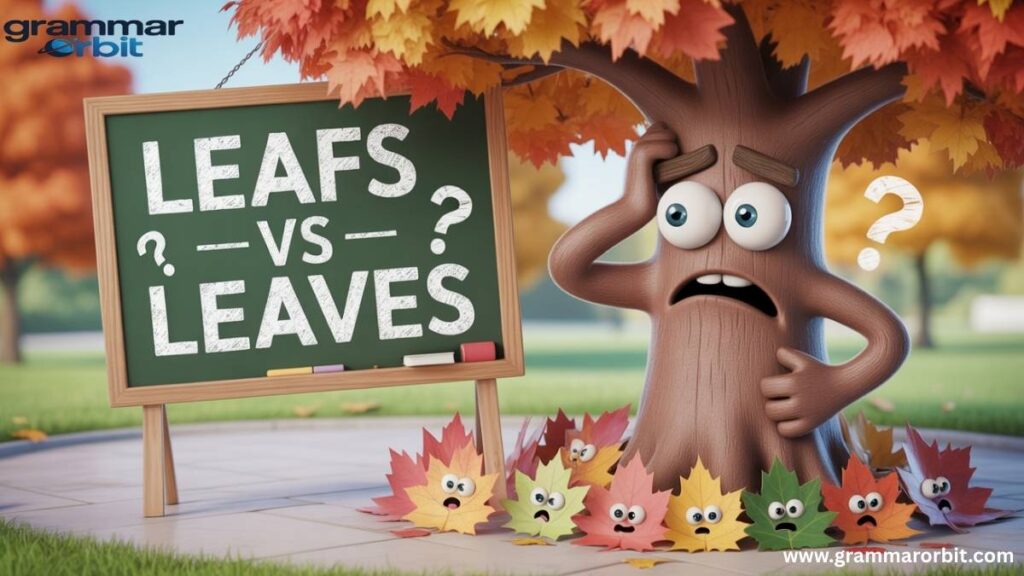
Grammar exceptions like leafs vs leaves remind us that English constantly evolves. Language follows rules, but people shape it through culture, tradition, and creativity.
Knowing both forms helps you write accurately while understanding how context changes meaning. You can follow grammar without sounding stiff or robotic. Good communication depends on clarity, not just perfection.
A famous teacher once said, “Grammar should serve the message, not silence it.” That truth fits perfectly here.
Quick Recap Leafs or Leaves
Here is everything you need to remember in one glance:
| Use | Correct Form | Example |
|---|---|---|
| Nature | Leaves | The leaves are green. |
| Verb (turn pages) | Leafs | She leafs through the report. |
| Proper noun (team) | Leafs | The Toronto Maple Leafs played well. |
Simple rule:
When you talk about plants, use leaves.
When you describe action or hockey, use leafs.
Reference: Cambridge Dictionary Definitions
Here’s a trusted source for clear word meanings:
FAQs
Which is correct, leaf or leaves?
Leaves is the correct plural form of leaf. When you talk about more than one leaf from a plant or tree, you always say leaves. For example, “The leaves are turning red in autumn.” The word leaf is singular and refers to one leaf only.
Is it leafs or leaves on a tree?
It’s leaves on a tree. Trees have leaves, not leafs, because leaves follows the English rule where nouns ending in f often change to ves when pluralized. So one leaf, two leaves, and never “two leafs on a tree.”
Is it two leaves or two leafs?
The correct phrase is two leaves. The word leafs doesn’t work here because you’re describing more than one leaf, which requires the irregular plural form leaves. Always remember: one leaf, many leaves.
Why leafs instead of leaves?
Leafs appears only in special contexts. It’s correct when referring to the Toronto Maple Leafs hockey team or when using leaf as a verb, as in “He leafs through the book.” In every other situation involving plants or nature, leaves is the right choice.
Is it Leafs or Leaves in a table?
If you mean the extensions or folding parts of a table, you can use either Leafs or Leaves, but leaves is more widely accepted. For example, “The dining table has two leaves that can be added for extra space.” The spelling leafs is rare in this case and mostly avoided in formal writing.
Would you like me to add structured FAQ schema markup (JSON LD) for better SEO ranking? It helps Google feature these questions directly in search results.
Conclusion
So there you have it the epic saga of Leafs or Leaves finally settled. Turns out, English grammar can be as unpredictable as autumn weather. One moment it’s all rules and structure, and the next, a hockey team strolls in and rewrites the dictionary.
If you’re talking about trees, go with leaves. If you’re flipping through a book, he leafs through it. And if you’re cheering at a hockey game, shout for the Toronto Maple Leafs like grammar never existed.
Because sometimes, language isn’t about perfection it’s about personality. And honestly, that’s what keeps English so wonderfully alive (and a little mischievous).
JHON AJS is an experienced blogger and the creative voice behind the website grammarorbit.com, namely Grammar Orbit. With a keen eye for language and a passion for wordplay, he creates engaging grammar insights, word meanings, and clever content that make learning English enjoyable and interesting for readers.

